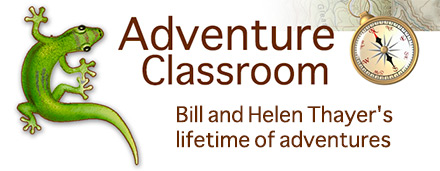


ENDURING CULTURES
Long before Columbus visited North America there were cultures around the world, ancient even then, who had endured for generations by living in harmony with their environment. They still exist today.We are privileged to have lived with various cultures worldwide. We are profoundly grateful for the insights these people offer when we set aside our western ways and integrate as much as possible into their societies. Our goal is to experience first hand these ancient ways and then to pass on what we learn to students through lectures, writing, photography, and the Adventure Classroom website. Simply stated: we seek a greater understanding of ancient lifestyles - to learn from beliefs and customs that differs from our own - in order to create a greater understanding of ourselves.
We are always fascinated by the practical sense of reality that exists in cultures that are often regarded as "primitive" compared to western cultures. Rather than "primitive" we instead have discovered a deep sense of family unity, insightful environmental accord, individual and group discipline, and a profound respect for elders.
Their reality is different from the western sense of reality. To exist at all, their reality deals with basic needs, their surrounding environment and challenges of survival. In times of famine for example, just how to make it through another day requires great ingenuity and practical skills. These societies are just as intricate as any western society, just in different ways. We often have little understanding of their ways; they usually have no concept of ours. It is vital that we strive to understand each other and the importance of all cultures, both western and ancient, in our diverse world. Toward that end, we present this section of brief observations of some of the people we have visited - to promote a deeper appreciation for enduring cultures that are successfully living on the earth.
MAASAI - Tanzania
The Maasai are an indigenous, semi-nomadic people located in northern Tanzania and eastern Kenya along the Great Rift Valley. The land is semi-arid and supports a population of approximately one half million people. The Maasai are a cattle herding people and derive their entire sustenance from their precious herds. They live under a communal land management system and move their livestock with the seasons.
[SEE MORE]
HADZA or BUSHMEN - Tanzania
The Hadza or Bushmen people are an ethnic group living in central Tanzania around Lake Eyasi in the central Rift Valley and in the neighboring Serengeti Plateau. The Bushmen people raise no livestock, grow no food, and live without calendars or rules. They are living a hunter-gatherer existence that is little changed from 10,000 years ago.
[SEE MORE]
DATOOGA - Tanzania
There is little written about the Datooga people. Their migration history and origins are thought to be in the Southern Sudan or western Ethiopia highlands, probably 3,000 years ago. They were gradually pushed southward by the fierce Maasai warriors. Rather than stay and fight, the Datooga chose to migrate south to the volcanic-rich highland areas of Kenya and Tanzania where they began cattle herding and farming.
[SEE MORE]
BERBERS - North Africa/Sahara
The Berbers lived in north Africa long before the arrival of the Arabs. Their culture dates back more than 4,000 years. Berbers have struggled for power in North Africa with Arab tribes for centuries. Today Berbers live in scattered communities across the Saharan countries of Morocco, Algeria, Tunisia, Libya, Egypt, Mali, Niger, and Mauritania. They speak various Amazigh languages belonging to the Afro-Asiatic family related to Ancient Egyptian. The Sahara Berbers still live the difficult traditional nomad's lifestyle herding sheep, goats and camels along traditional family routes to find water and food. Some have settled in villages where they cultivate land to secure a food supply for their families and animals that is less susceptible to Saharan drought.
[SEE MORE]
GOBI MONGOL NOMADS - Mongolia
The Gobi Desert is one of the few places on Earth that has been able to retain its culture and traditions from ancient history. The landlocked position, harsh environment, and rocky geography of the Gobi have prevented the culture from changing much over the years. Because the climate is so extreme, anyone living on the Gobi must remain close to animal herds. Mongolia has the highest number of horses per capita. Mongolia was the first nation in the world to introduce paper money. In Mongolia, before the Communist purge of 1929-1937, there were more than 700 monasteries with more than 100,000 monks. After the Communist purge, no monks were left and only six temples remained.
[SEE MORE]
